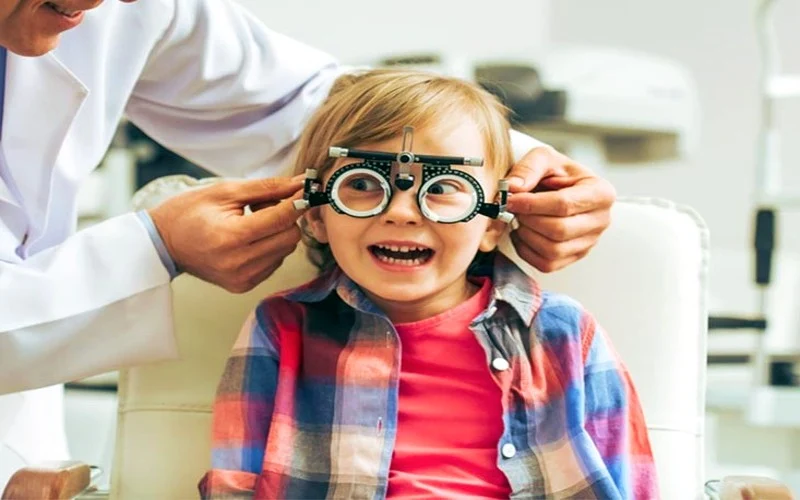Why Should You Take Your Child to an Eye Specialist? 5 Signs Your Child Needs To See an Ophthalmologist
 |
| 5 Reasons To Take Your Child To A Children's Ophthalmologist |
Good visual health is essential for correct learning and development in children. During their growth, it is very important to pay attention to their vision to be able to detect and correct any problems that may appear in their eyesight in time and avoid major complications in the future.
It is always a good time to take your child to a children's ophthalmologist for an eye examination, but if you are still not sure, this blog post will give you 5 reasons to do so:
The first years of life are critical for a child's visual development.
When we are born our visual system is not fully developed and during the first years important physiological and anatomical changes occur that continue until after puberty.
Until approximately six years of age, visual skills such as visual acuity, motor coordination between the two eyes, perception of space in three dimensions, the ability to focus, etc. are acquired.
Around the age of twelve is when the maturity of the visual system is reached. For this reason, it is important to monitor that our children's ocular system evolves correctly during their growth.
Detect and correct the visual problem as soon as possible.
Regular check-ups by a children's ophthalmologist allow vision problems to be detected early. This way we can give it a solution before it gets worse. Myopia, hyperopia, astigmatism, and lazy eye (amblyopia) are very common eye conditions in children and if they are corrected from the first moment, their subsequent evolution can greatly improve.
Children are not vocal about having eyesight issues.
Rarely will we find a child commenting that he has vision problems. Even in cases of blurred vision, they may not know how to convey it to their parents or may even think that the way they see things is completely normal.
Avoid problems of poor school performance.
Vision problems make it difficult to carry out daily school activities such as reading and seeing the blackboard, which can make learning difficult and affect school performance. Integration problems or school failure may be due to the child having vision difficulties and are often confused with behavioral problems or lack of attention.
There are eye diseases that are hereditary.
Children whose parents have vision problems such as myopia, astigmatism, and hyperopia have a high probability of suffering from these eye conditions. Therefore, in these cases, we must be especially attentive and take them to the children's ophthalmologist for preventive check-ups.
What is amblyopia, often known as lazy eye, and how is it treated?
Amblyopia, also referred to as "lazy or lazy eye," is one of the most prevalent eye diseases in kids. It is estimated that approximately 3 to 4% of school-age children have amblyopia. But what exactly is lazy eye?
Amblyopia or lazy eye is a vision disorder that manifests itself as a decrease in visual acuity. It usually affects one eye, although it can occur in both. It usually originates as a consequence of poor development of visual capacity during childhood (approximately before the age of 6 or 8).
Why does lazy eye occur?
The causes of amblyopia can be several. It can be caused by strabismus, a difference in prescription between both eyes (anisometric), a refractive error (myopia, hyperopia, or astigmatism), a congenital cataract, eyelid ptosis (drooping of the eyelid), or by any reason that prevents adequate visual stimulation. during the critical period of the child's visual development.
Visual stimuli are essential for the development of vision. For vision to develop correctly, it is very important that the brain receives quality images (sharp and focused) simultaneously in both eyes.
When this does not happen and the image does not arrive with the same quality in one of the eyes, the brain ends up ignoring the visual information it receives from that eye, which ends up becoming “lazy.” Once the visual system has matured, the risk of the child developing amblyopia disappears.
How is amblyopia treated?
In amblyopia, early detection and treatment at the appropriate time in the child's development is essential. If the treatment is performed at the correct time, vision can be fully recovered in most cases. Otherwise, lazy eye can last until the adult stage when it is not possible to correct it.
Amblyopia in children can go unnoticed since one of the eyes has normal vision. For this reason, periodic ophthalmological check-ups are essential in children before 3 years of age.
Treatments for amblyopia aim to correct the origin. The best-known method is ocular occlusion or patching. It consists of covering the eye that sees well with a patch to exercise the amblyopic eye. If the origin is a refractive error such as hyperopia, astigmatism or myopia, glasses with the appropriate prescription are used. Vision therapy can also give good results in certain cases of amblyopia.
You already know what amblyopia or lazy eye is and that there are different ways to treat it depending on its origin. The most important thing for the child's vision recovery to be complete is that it is detected and corrected in time. For this reason, periodic check-ups in the ophthalmological clinic are essential.
